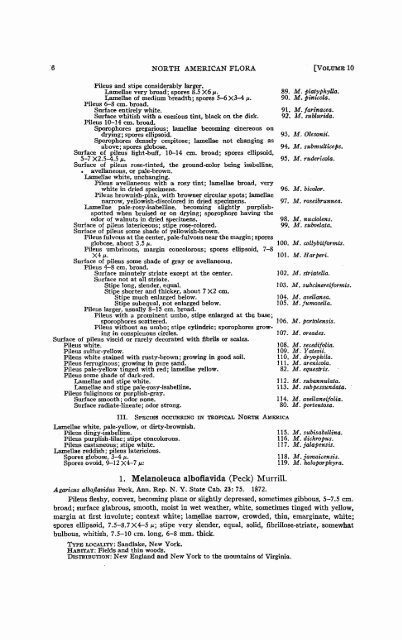North American Flora: Agaricales, Agaricaceae (Vol. 10 ... - MykoWeb
North American Flora: Agaricales, Agaricaceae (Vol. 10 ... - MykoWeb
North American Flora: Agaricales, Agaricaceae (Vol. 10 ... - MykoWeb
Create successful ePaper yourself
Turn your PDF publications into a flip-book with our unique Google optimized e-Paper software.
NORTH AMERICAN FLORA [VOLUME <strong>10</strong><br />
Pileus and stipe considerably larger.<br />
Lamellae very broad; spores 8.5 X6 p.<br />
Lamellae of medium breadth; spores 5-6 X3-4 p..<br />
Pileus 6-8 cm. broad.<br />
Surface entirely white.<br />
Surface whitish with a caesious tint, black on the disk.<br />
Pileus <strong>10</strong>-14 cm. broad.<br />
Sporophores gregarious; lamellae becoming cinereous on<br />
drying; spores ellipsoid.<br />
Sporophores densely cespitóse; lamellae not changing as<br />
above; spores globose.<br />
Surface of pileus light-buff, <strong>10</strong>-14 cm. broad; spores ellipsoid,<br />
5-7 X2.5-4.5 M.<br />
Surface of pileus rose-tinted, the ground-color being isabelline,<br />
4 avellaneous, or pale-brown.<br />
Lamellae white, unchanging.<br />
Pileus avellaneous with a rosy tint; lamellae broad, very<br />
white in dried specimens.<br />
Pileus brownish-pink, with browner circular spots; lamellae<br />
narrow, yellowish-discolored in dried specimens.<br />
Lamellae pale-rosy-isabelline, becoming slightly purplish-<br />
spotted when bruised or on drying; sporophore having the<br />
odor of walnuts in dried specimens.<br />
Surface of pileus latericeous; stipe rose-colored.<br />
Surface of pileus some shade of yellowish-brown.<br />
Pileus fulvous at the center, pale-fulvous near the margin; spores<br />
globose, about 3.5 ¡i.<br />
Pileus umbrinous, margin concolorous; spores ellipsoid, 7-8<br />
Xiß.<br />
Surface of pileus some shade of gray or avellaneous.<br />
Pileus 4-8 cm. broad.<br />
Surface minutely striate except at the center.<br />
Surface not at all striate.<br />
Stipe long, slender, equal.<br />
Stipe shorter and thicker, about 7 X2 cm.<br />
Stipe much enlarged below.<br />
Stipe subequal, not enlarged below.<br />
Pileus larger, usually 8-15 cm. broad.<br />
Pileus with a prominent umbo, stipe enlarged at the base;<br />
sporophores scattered.<br />
Pileus without an umbo; stipe cylindric; sporophores grow-<br />
ing in conspicuous circles.<br />
Surface of pileus viscid or rarely decorated with fibrils or scales.<br />
Pileus white.<br />
Pileus sulfur-yellow.<br />
Pileus white stained with rusty-brown; growing in good soil.<br />
Pileus ferruginous ; growing in pure sand.<br />
Pileus pale-yellow tinged with red; lamellae yellow.<br />
Pileus some shade of dark-red.<br />
Lamellae and stipe white.<br />
Lamellae and stipe pale-rosy-isabelline.<br />
Pileus fuliginous or purplish-gray.<br />
Surface smooth; odor none.<br />
Surface radiate-lineate; odor strong.<br />
89.<br />
90.<br />
91.<br />
92.<br />
93. M. Olesonii.<br />
94. M. submulticeps.<br />
95. M. rudericola.<br />
96. M. bicolor.<br />
97.<br />
98.<br />
99.<br />
<strong>10</strong>0.<br />
<strong>10</strong>1.<br />
<strong>10</strong>2.<br />
<strong>10</strong>3. M. subcinereiformis.<br />
<strong>10</strong>4.<br />
<strong>10</strong>5.<br />
<strong>10</strong>6. M. portolensis.<br />
<strong>10</strong>7. M. oreades.<br />
<strong>10</strong>8.<br />
<strong>10</strong>9.<br />
1<strong>10</strong>.<br />
111.<br />
82.<br />
112.<br />
113.<br />
114.<br />
80.<br />
III. SPECIES OCCURRING IN TROPICAL NORTH AMERICA<br />
Lamellae white, pale-yellow, or dirty-brownish.<br />
Pileus dingy-isabelline.<br />
Pileus purplish-lilac; stipe concolorous.<br />
Pileus castaneous ; stipe white.<br />
Lamellae reddish; pileus latericious.<br />
Spores globose, 3-4 /t.<br />
Spores ovoid, 9-12 X4-7 ft:<br />
M. platyphytta.<br />
M. pinícola.<br />
M. farinácea.<br />
M. suUurida.<br />
M. roseibrunnea.<br />
M. nuciolens.<br />
M. subvelata.<br />
M. collybiiformis.<br />
M. Harperi.<br />
M. striatella.<br />
M. avellanea.<br />
M. fumosella.<br />
M. secedifolia.<br />
M. Yatesii.<br />
M. dryophila.<br />
M. arenicola.<br />
M. equestris.<br />
M. subannulata.<br />
M. subpessundata.<br />
M. avellaneifolia.<br />
M. portentosa.<br />
115. M. subisabellina.<br />
116. M. dichropus.<br />
117. M.jalapensis.<br />
118. M. jamaicensis.<br />
119. M. holoporphyra.<br />
1. Melanoleuca alboflavida (Peck) Murrill.<br />
Agaricus alboflavidus Peck, Ann. Rep. N. Y. State Cab. 23: 75. 1872.<br />
Pileus fleshy, convex, becoming plane or slightly depressed, sometimes gibbous, 5-7.5 cm.<br />
broad; surface glabrous, smooth, moist in wet weather, white, sometimes tinged with yellow,<br />
margin at first involute; context white; lamellae narrow, crowded, thin, emarginate, white;<br />
spores ellipsoid, 7.5-8.7X4-5 M; stipe very slender, equal, solid, fibrillose-striate, somewhat<br />
bulbous, whitish, 7.5-<strong>10</strong> cm. long, 6-8 mm. thick.<br />
TYPE LOCALITY: Sandlake, New York.<br />
HABITAT: Fields and thin woods.<br />
DISTRIBUTION: New England and New York to the mountains of Virginia.
















